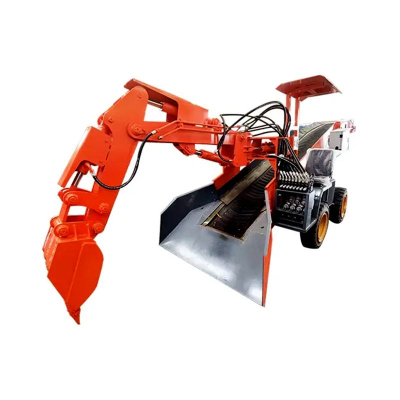Modular Mining LHD: One Machine, Multiple Capabilities Reshaping Underground Operational Ecology
Recently, the modular mining LHD (Load-Haul-Dump Machine) launched by Shandong Beijun Machinery Industry Co., Ltd. leverages rapid attachment switching technology to achieve seamless adaptation to scenarios such as underground hard rock crushing, classified material transportation, and multi-process collaborative operations. With the innovative logic of “one machine, multiple capabilities”, it breaks the functional boundaries of traditional mining equipment, providing underground mines with a new operational paradigm characterized by “high efficiency, flexibility, and cost reduction”.
I. Modular Attachments: 5-Minute Switching, Covering All Underground Processes
Equipped with a mining-standard quick-change interface, the equipment adopts a modular design of “mainframe platform + exclusive attachment library”, enabling attachment switching within 5–10 minutes to precisely meet diverse underground needs:
Breaker Attachment: Specializes in pre-crushing high-hardness ore bodies (e.g., gold ore veins, copper ore hard rock areas). The hydraulic system dynamically adjusts impact frequency and force by real-time sensing of rock hardness, achieving “efficient crushing + low wear”. Pre-crushing hard rock can increase subsequent loading efficiency by 30% and reduce the risk of rock mass disturbance from blasting.
Forklift Attachment: Adapts to long material transportation (e.g., underground support bolts, steel materials, roadway timbering components) and regular material handling (prefabricated concrete blocks, equipment parts), solving the pain point of traditional buckets “struggling to grasp long or regular items” and facilitating timely delivery of stope support materials.
Multi-Level Bucket Attachments: Offer optional volumes from 0.5 to 3 m³. Smaller buckets are used for thin ore bodies (precision ore extraction, reducing dilution), while larger buckets match thick ore bodies (increasing single-transport volume). Enclosed dust-proof buckets can also be customized for ore bin cleaning in high-dust environments.
II. Scene Deepening: Focus on Optimizing Full-Process Underground Operations
Leveraging modular advantages, the equipment deeply penetrates core underground mining scenarios:
Hard Rock Mine Crushing Scene: At a gold mine in Jiaodong, the breaker-equipped model performs “pre-crushing” on underground quartz vein hard rock, increasing subsequent loading efficiency by 35%, reducing blasting frequency, and shortening the operation cycle time.
Polymetallic Ore Sorting Scene: At a lead-zinc mine in Western Yunnan, the forklift-equipped model precisely transports ore blocks of different grades (high-grade to the concentrator area, low-grade to the preconcentration area). Combined with an intelligent recognition system, it achieves “preliminary underground sorting”, reducing unnecessary transportation costs.
Deep Mine Roadway Collaboration Scene: In a deep coal mine in Northern Anhui (800 meters below ground), the same equipment uses a bucket attachment to remove roadway waste rock in the morning and switches to a breaker attachment to crush hard rock at the face in the afternoon. This reduces equipment transfer frequency, increasing the stope equipment turnover rate by 25%.
III. Technological Breakthroughs: Mining-Customized Design Secures Safe and Efficient Foundations
The equipment’s scene adaptability stems from in-depth polishing of mining-exclusive technologies:
Mining Safety Redundancy: The entire series has passed mining explosion-proof certification (suitable for high-gas mines), equipped with anti-skid chains, overload protection, and rock-fall protection shields to meet complex underground safety requirements.
Mining-Specific Hydraulic System Optimization: Adopts a high-pressure dust-proof hydraulic circuit to withstand underground dust and bumpy conditions. Automatic oil temperature regulation technology ensures stable operation in an ambient temperature range of -10℃ to 45℃.
Intelligent Working Condition Adaptation: The breaker has a built-in rock hardness sensor to automatically match impact parameters; the bucket is equipped with a load monitoring system to prevent material jamming and overloading, extending equipment lifespan.
IV. Industry Value: Cost Reduction and Efficiency Drive the Iteration of Mining Equipment
Driven by the rigid demand for “cost reduction and efficiency improvement” in mines, the modular LHD is reshaping underground operational logic:
Cost Aspect: A single unit can replace 3 types of specialized equipment (crushers, load-haul-dumpers, forklifts), reducing procurement costs by 40% and operation & maintenance costs by 35% (universal spare parts for a unified platform).
Efficiency Aspect: Seamless switching between multiple processes compresses stope operation cycle time by 20%, with significant advantages in small and medium-sized mines (complex ore body shapes, difficult equipment scheduling).
Market Aspect: In the first half of 2025, year-on-year orders for modular mining LHDs increased by 60%, covering metallic mines (gold, copper, lead-zinc), non-metallic mines (limestone, gypsum), and coal mines. Customized demands in overseas markets (Southeast Asia, Africa) have also surged simultaneously.
From hard rock crushing to precision material transportation, and from single-process operations to full-process collaboration, the modular mining LHD is redefining the value boundaries of underground equipment with “one machine, multiple capabilities”. As unmanned and hydrogen energy technologies integrate, such “scene-adaptive” equipment is poised to become a core carrier for the intelligent upgrade of underground mines, driving the mining industry toward greater efficiency and flexibility.



